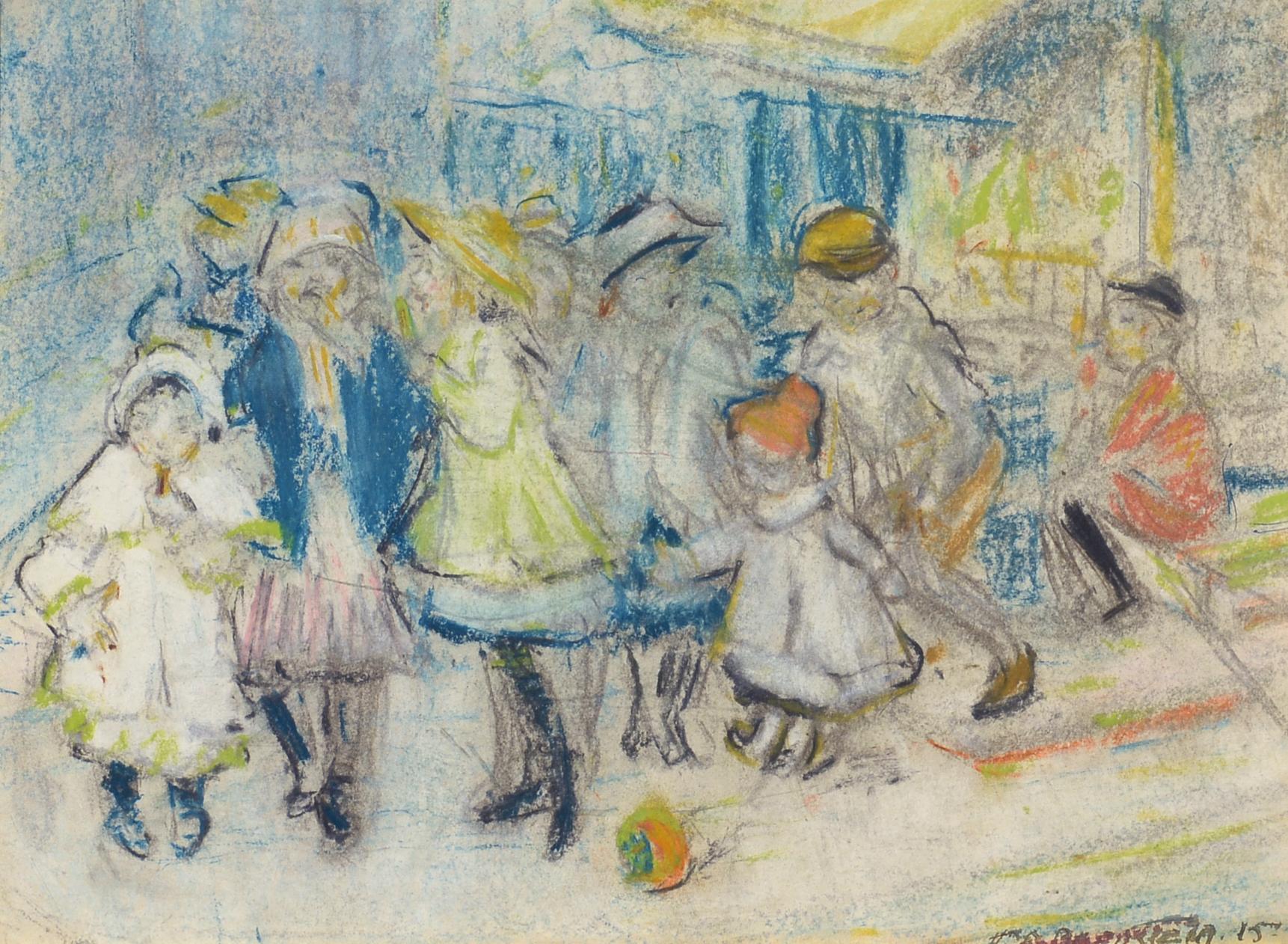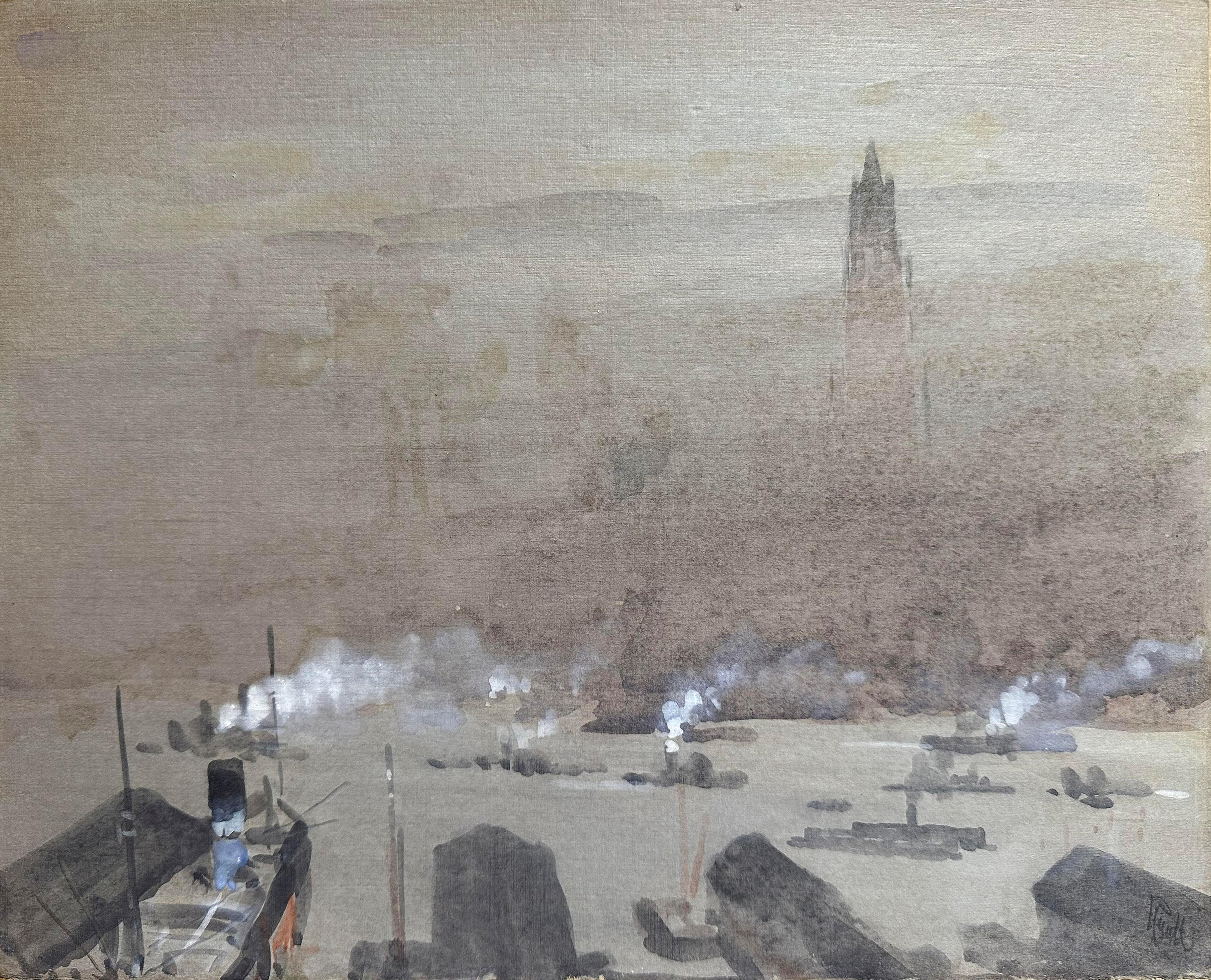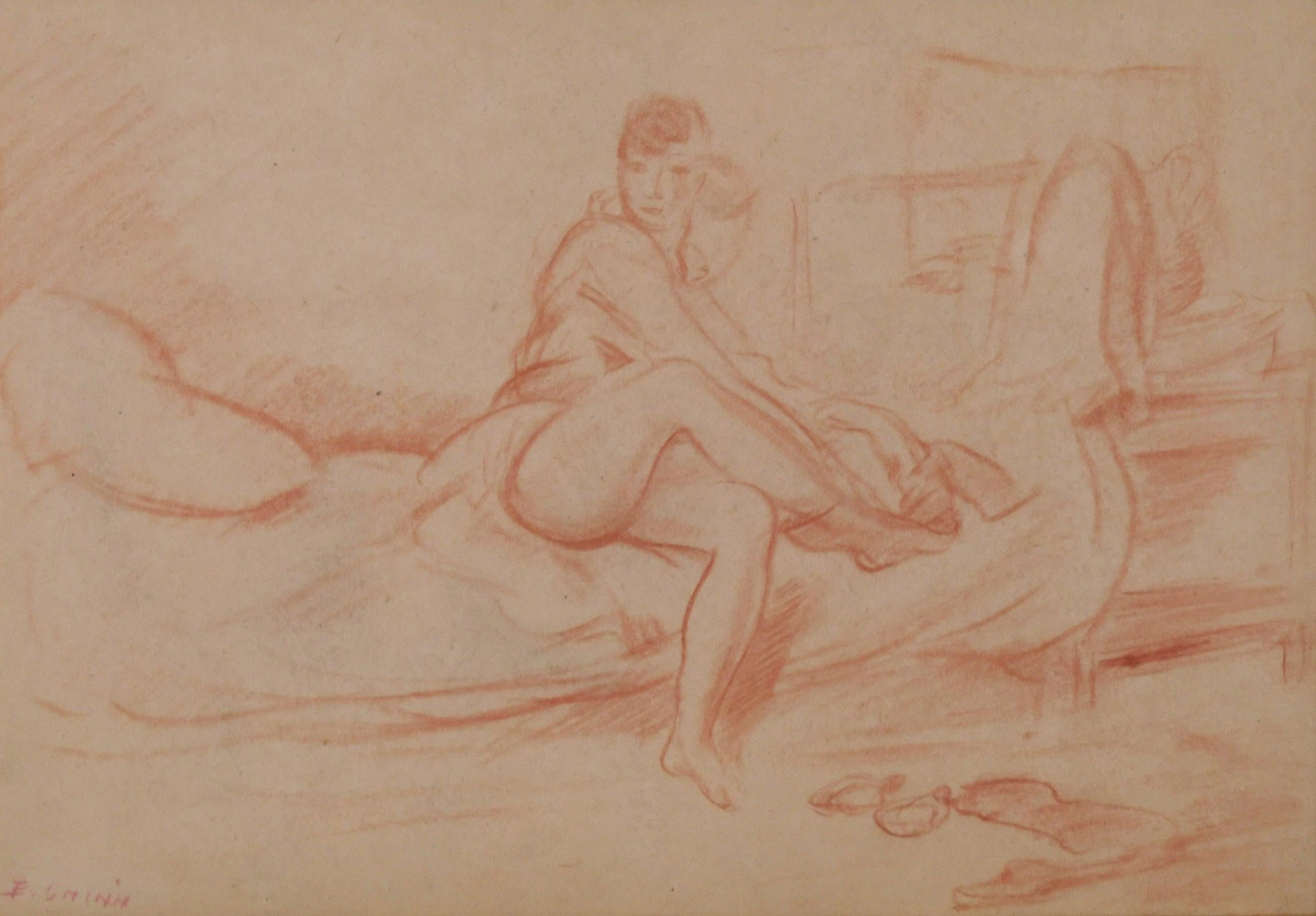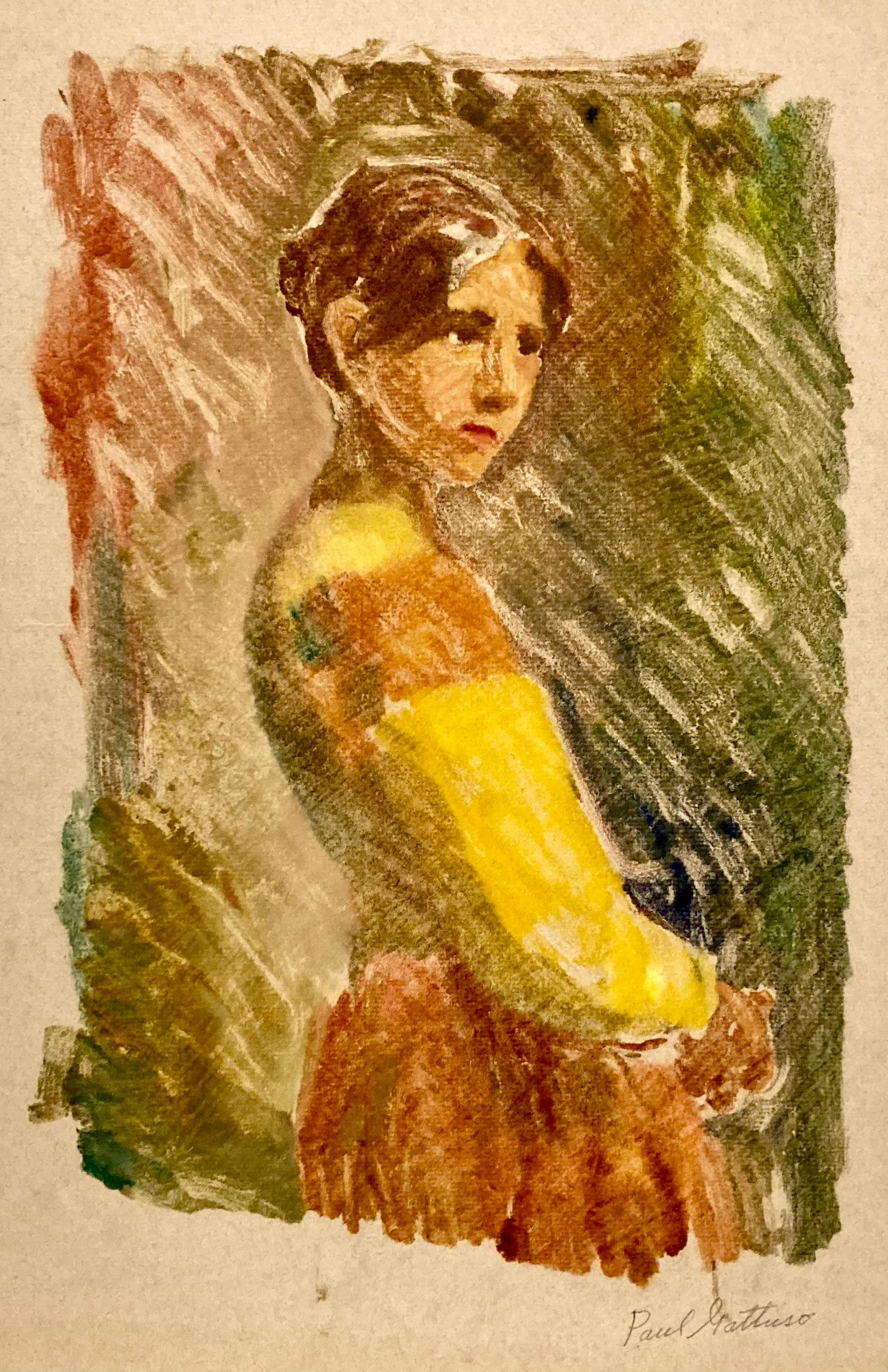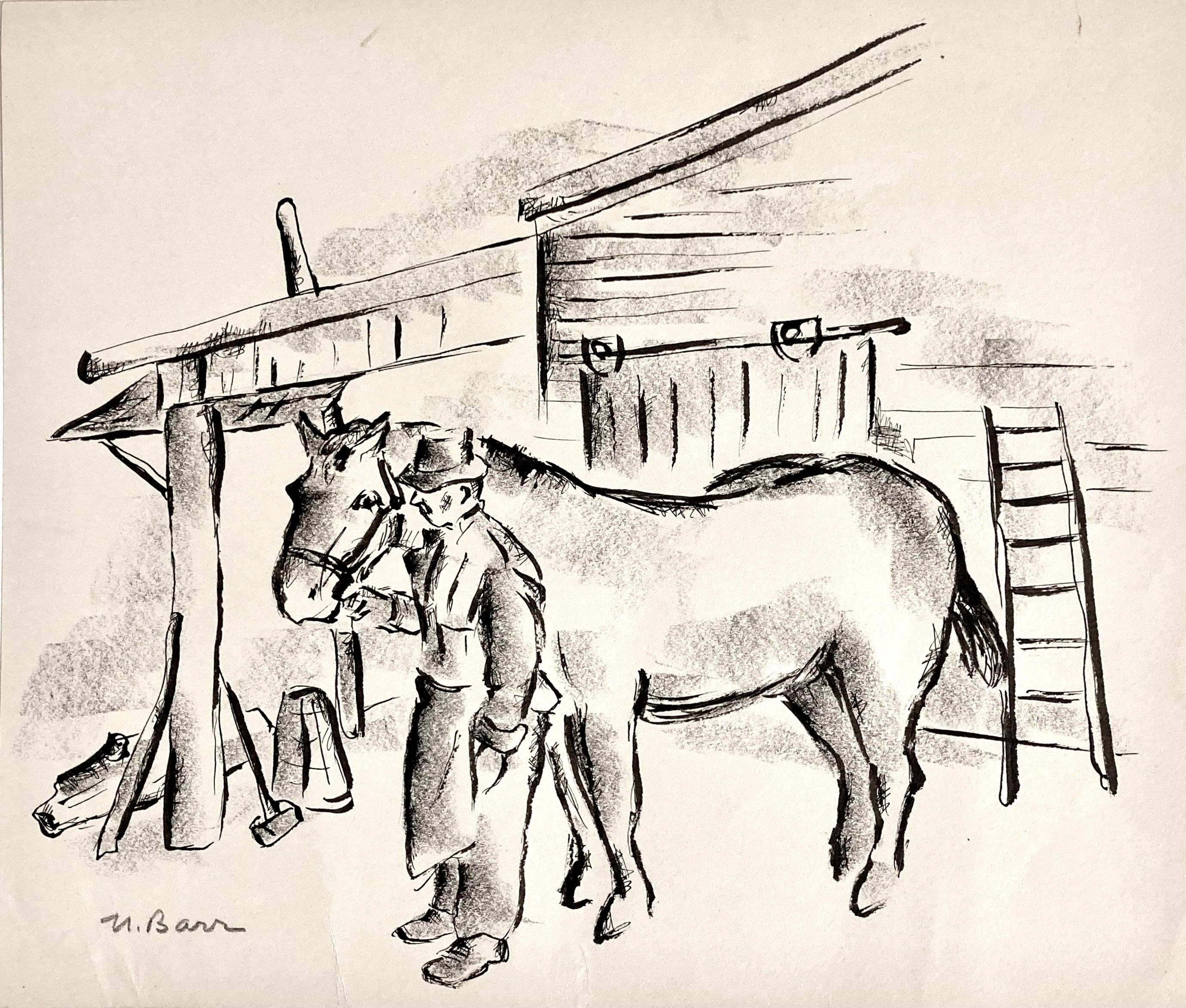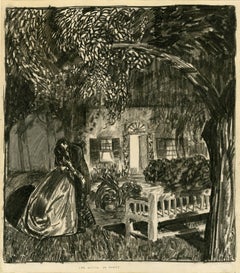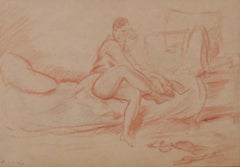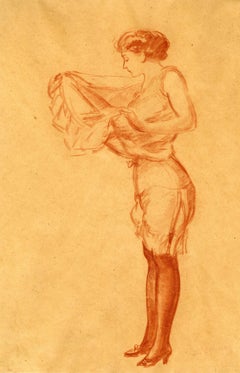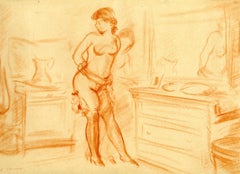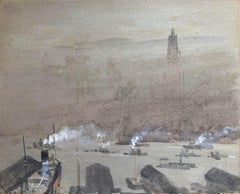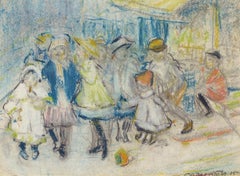Ashcan School Drawings and Watercolor Paintings
to
4
23
5
4
Overall Width
to
Overall Height
to
1
30
1
2
4
7
5
1
1
7,313
7,263
5,033
3,070
608
591
499
414
378
312
262
177
81
61
18
13
1
22
14
9
9
7
4
2
2
2
2
2
2
2
1
1
1
1
1
1
1
11
10
6
5
5
5
3
3
2
1
11
32
Style: Ashcan School
The Mouth of Honey
Located in Fairlawn, OH
The Mouth of Honey
Lithographic crayon and mixed media on paper mounted to support paper
Initialed by the artist "GB" bottom center on image. (see photo)
Titled in pencil in bottom m...
Category
1920s Ashcan School Drawings and Watercolor Paintings
Materials
Crayon
Untitled (Woman Removing Her Stockings)
Located in Fairlawn, OH
Untitled (Woman Removing Her Stockings)
Conte crayon on paper. c. 1905
Signed lower right: E Shinn
Provenance:
James Graham & Sons, New York (labels)
Ronald C. Sloter, Columbus
Colum...
Category
Early 1900s Ashcan School Drawings and Watercolor Paintings
Materials
Conté
Woman Pulling on a Slip
Located in Fairlawn, OH
Woman Pulling on a Slip
Conte on paper, c. 1910
Signed lower right: "E. Shinn" (see photo of legs, signature on right)
Provenance:
Estate of the Artist (see label)
Graham Gallery, N...
Category
1910s Ashcan School Drawings and Watercolor Paintings
Materials
Conté
Untitled (Woman in Stockings), Standing Female Nude on reverse, double sided
Located in Fairlawn, OH
Conte crayon on paper, c. 1905-1909
Signed lower right
Archival frame by Graham Gallery, New York, hand carved frame with silk matting and gold fillet (see photo of corner)
Provenanc...
Category
Early 1900s Ashcan School Drawings and Watercolor Paintings
Materials
Chalk
"View of Manhattan and the Woolworth Building" Joseph Pennell, New York Scene
Located in New York, NY
Joseph Pennell
View of Manhattan and the Woolworth Building, East River, circa 1915
Signed lower right
Watercolor with white bodycolor on paper
10 x 12 3/4 inches
Provenance
Arader ...
Category
1910s Ashcan School Drawings and Watercolor Paintings
Materials
Paper, Watercolor
Children at Play, 1915, Ashcan School, New York, American, Park, Pastel on Paper
Located in Wiscasset, ME
Born in Philadelphia in 1890, Theresa Bernstein showed early talent and interest in art. At the age of seventeen, she won a Board of Education scholarship to attend the Philadelphia ...
Category
1950s Ashcan School Drawings and Watercolor Paintings
Materials
Paper, Pastel
"Beach at Atlantic City, New Jersey" Amy Londoner, Ashcan School, Figurative
By Amy Londoner
Located in New York, NY
Amy Londoner
Beach at Atlantic City, circa 1922
Signed lower right
Pastel on paper
Sight 23 x 18 inches
Amy Londoner (April 12, 1875 – 1951) was an American painter who exhibited at the 1913 Armory Show. One of the first students of the Henri School of Art in 1909. Prior to the Armory Show of 1913, Amy Londoner and her classmates studied with "Ashcan" painter Robert Henri at the Henri School of Art in New York, N.Y. One notable oil painting, 'The Vase', was painted by both Henri and Londoner.
Londoner was born in Lexington, Missouri on April 12, 1875. Her parents were Moses and Rebecca Londoner, who moved to Leadville, Colorado, by 1880. In 1899, Amy took responsibility for her father who had come to Los Angeles from Leadville and had mental issues. By 1900, Amy was living with her parents and sister, Blanche, in the vicinity of Leadville, Denver, Colorado. While little was written about her early life, Denver City directories indicated that nineteenth-century members of the family were merchants, with family ties to New York, N.Y. The family had a male servant. Londoner traveled with her mother to England in 1907 then shortly later, both returned to New York in 1909. Londoner was 34 years old at the time, and, according to standards of the day, should have married and raised a family long before. Instead, she enrolled as one of the first students at the Henri School of Art in 1909.
At the Henri School, Londoner established friendships with Carl Sprinchorn (1887-1971), a young Swedish immigrant, and Edith Reynolds (1883-1964), daughter of wealthy industrialist family from Wilkes-Barre, PA. Londoner's correspondence, which often included references to Blanche, listed the sisters' primary address as the Hotel Endicott at 81st Street and Columbus Avenue, NYC. Other correspondence also reached Londoner in the city via Mrs. Theodore Bernstein at 252 West 74th Street; 102 West 73rd Street; and the Independent School of Art at 1947 Broadway. In 1911, Londoner vacationed at the Hotel Trexler in Atlantic City, NJ. As indicated by an undated photograph, Londoner also spent time with Edith Reynolds and Robert Henri at 'The Pines', the Reynolds family estate in Bear Creek, PA.
Through her connections with the Henri School, Londoner entered progressive social and professional circles. Henri's admonition, phrased in the vocabulary of his historical time period, that one must become a "man" first and an artist second, attracted both male and female students to classes where development of unique personal styles, tailored to convey individual insights and experiences, was prized above the mastery of standardized, technical skill. Far from being dilettantes, women students at the Henri School were daring individuals willing to challenge tradition. As noted by former student Helen Appleton Read, "it was a mark of defiance,to join the radical Henri group."
As Henri offered educational alternatives for women artists, he initiated exhibition opportunities for them as well. Troubled by the exclusion of work by younger artists from annual exhibitions at the National Academy of Design, Henri was instrumental in organizing the no-jury, no-prize Exhibition of Independent Artists in 1910. About half of the 103 artists included in the exhibition were or had been Henri students, while twenty of the twenty-six women exhibiting had studied with Henri. Among the exhibition's 631 pieces, nine were by Amy Londoner, including the notorious 'Lady with a Headache'. Similarly, fourteen of Henri's women students exhibited in the groundbreaking Armory Show of 1913, forming about eight percent of the American exhibitors and one-third of American women exhibitors. Of the nine documented works submitted by Londoner, five were rejected, while four pastels of Atlantic City beach scenes, including 'The Beach Umbrellas' now in the Remington Collection, were displayed.
Following Henri's example, Londoner served as an art instructor for younger students at the Modern School, whose only requirement was to genuinely draw what they pleased. The work of dancer Isadora Duncan, another artist devoted to the ideals of a liberal education, was also lauded by the Modern School. Henri, who long admired Duncan and invited members of her troupe to model for his classes, wrote an appreciation of her for the Modern School journal in 1915. She was also the subject of Londoner's pastel Isadora Duncan and the Children: Praise Ye the Lord with Dance. In 1914, Londoner traveled to France to spend summer abroad, living at 99 rue Notre Dames des Champs, Paris, France. As the tenets of European modernism spread throughout the United States, Londoner showed regularly at venues which a new generation of artists considered increasingly passe, including the annual Society of Independent Artists' exhibitions between 1918 and 1934, and the Salons of America exhibition in 1922. Londoner also exhibited at the Morton Gallery, Opportunity Gallery, Leonard Clayton Gallery and Brownell-Lambertson Galleries in NYC. Her painting of a 'Blond Girl' was one of two works included in the College Art Associations Traveling Exhibition of 1929, which toured colleges across the country to broad acclaim.
Londoner later in life suffered from illnesses then suffered a stroke which resulted in medical bills significantly mounting over the years that her old friends from the Henri School, including Carl Sprinchorn, Florence Dreyfous, Florence Barley, and Josephine Nivison Hopper, scrambled to raise funds and find suitable long-term care facilities for Londoner. Londoner later joined Reynolds in Bear Creek, PA. Always known for her keen wit, Londoner retained her humor and concern for her works even during her illness, noting that "if anything happens to the Endicott, I guess they will just throw them out." Sprinchorn and Reynolds, however, did not allow this to happen. In 1960, Londoner's paintings 'Amsterdam Avenue at 74th Street' and 'The Builders' were loaned by Reynolds to a show commemorating the Fiftieth Anniversary of the Exhibition of Independent Artists in 1910, presented at the Delaware Art Center, Wilmington, DE. In the late 80's, Francis William Remington, 'Bill Remington', of Bear Creek Village PA, along with his neighbor and artist Frances Anstett Brennan, both had profound admiration for Amy Londoner's art work and accomplishments as a woman who played a significant role in the Ashcan movement. Remington acquired a significant number of Londoner's artwork along with Frances Anstett Brenan that later was part of an exhibition of Londoner's artwork in April 15 of 2007, at the Hope Horn...
Category
1920s Ashcan School Drawings and Watercolor Paintings
Materials
Paper, Pastel
Head of a Woman (Margaret)
By Leon Kroll
Located in Fairlawn, OH
Head of a Woman (Margaret)
conte on wove paper, 1925
Signed and dated lower right
Annotated "Margaret" in ink verso
A portrait of Margaret Cassidy Manship ( d. 2012), daughter in law...
Category
1920s Ashcan School Drawings and Watercolor Paintings
Materials
Conté
Fulton St. Fish Market, Crating (NYC)
By Norman Barr
Located in New York, NY
Born in Czarist Russia Norman Barr (1908-1994) came to New York as a young boy and except for a few night classes at the school of the National Academy of ...
Category
Mid-20th Century Ashcan School Drawings and Watercolor Paintings
Materials
India Ink
Pencil Automobile Car Drawing
Located in Fredericksburg, VA
Jacques Villon, born Gaston Émile Duchamp on July 31, 1875, in Damville, France, was a pivotal figure in the development of modern art. As the elder brother of Marcel Duchamp, Raymond Duchamp-Villon, and Suzanne Duchamp-Crotti, Villon was part of a family that profoundly influenced 20th-century art. He adopted the pseudonym Jacques Villon to distinguish himself from his siblings, and began his career as a cartoonist and illustrator. Villon's contributions to modern art were acknowledged internationally, with exhibitions at prestigious venues such as the Salon d'Automne, the Salon des Indépendants, and the Armory Show in New York in 1913. His work influenced the trajectory of abstract art, and his legacy is celebrated in numerous museums and collections worldwide. While this drawing isnt common of his bolder cubist style, it shows his skill in sketching and shapes which add a dimension to the abstract nature of this automobile drawing...
Category
Early 20th Century Ashcan School Drawings and Watercolor Paintings
Materials
Paper, Graphite
Andrée Ruellan, Spring on Bleecker Street (Greenwich Village, NY), crayon, 1938
Located in New York, NY
Spring, Bleecker Street, Ruellan's conté crayon drawing from 1938, shows young people out in the world. And their world is Bleecker Street, New York City. The heart of Greenwich Vil...
Category
1930s Ashcan School Drawings and Watercolor Paintings
Materials
Crayon
“City Snow”
Located in Southampton, NY
Original watercolor and gouache city snowscape attributed to the hand of Hans Peter Nelson. Signed lower left ”H. Nelson”. Condition is excellent. Circa 1940. Under glass. The art...
Category
1940s Ashcan School Drawings and Watercolor Paintings
Materials
Watercolor, Gouache, Archival Paper
$396 Sale Price
20% Off
Norman Barr, Coney Island (large), 1940
By Norman Barr
Located in New York, NY
Norman Barr recorded his beloved New York City from the Bronx, to Coney Island, to the Fulton Fish Market.
In this period he was on the New Deal's Mural ...
Category
Mid-20th Century Ashcan School Drawings and Watercolor Paintings
Materials
Crayon, India Ink
Norman Barr, Delancey Street (NYC)
By Norman Barr
Located in New York, NY
Norman Barr recorded his beloved New York City from the Bronx, to Coney Island, to the Fulton Fish Market.
In this period he was on the New Deal's Mural ...
Category
Mid-20th Century Ashcan School Drawings and Watercolor Paintings
Materials
Crayon, India Ink
Norman Barr, Farm, North Bronx (NYC)
By Norman Barr
Located in New York, NY
Norman Barr recorded his beloved New York City from the Bronx, to Coney Island, to the Fulton Fish Market.
In this period he was on the New Deal's Mural ...
Category
Mid-20th Century Ashcan School Drawings and Watercolor Paintings
Materials
Crayon, India Ink
Louis Bouché, (Standing Woman)
By Louis Bouché
Located in New York, NY
Louis Bouché was based in New York and taught at the Art Students League. The figure was an important subject in his oeuvre. An ink drawing on tan paper, ...
Category
Early 20th Century Ashcan School Drawings and Watercolor Paintings
Materials
Ink
Paul Gattuso, (Italian Street Scene)
Located in New York, NY
Paul Gattuso attended the Art Students League and worked primarily in New York City. There is an old address with a Bronx, Grand Concourse address.
Gattus...
Category
1930s Ashcan School Drawings and Watercolor Paintings
Materials
Monotype
”Admiring the Picture”
Located in Southampton, NY
Very well executed original gouache on archival paper by the well known American artist Benjamin Kopman. The scene depicts three figures admiring a picture. Signed lower left. Circa ...
Category
1930s Ashcan School Drawings and Watercolor Paintings
Materials
Gouache, Archival Paper
$1,120 Sale Price
20% Off
red ballboy or Studies for "Tennis Tournament"
Located in Fairlawn, OH
Red Ballboy or Studies for "Tennis Tournament"
Crayon on paper, c. 1920
Unsigned
Condition: three vertical folds created by the artist to transport the drawing from the tennis match ...
Category
1910s Ashcan School Drawings and Watercolor Paintings
Materials
Graphite
Battle Scene, Spanish American War
Located in New York, NY
Francis Luis Mora was considered one of America's finest "sketchers". A collection of his Sketchbooks are at the Smithsonian and this work came out of one in the early 1990's from t...
Category
1890s Ashcan School Drawings and Watercolor Paintings
Materials
Graphite
$1,040 Sale Price
20% Off
Paul Gattuso, (Young Woman)
Located in New York, NY
Paul Gattuso attended the Art Students League and worked primarily in New York City. There is an old address with a Bronx, Grand Concourse address.
Gattus...
Category
1930s Ashcan School Drawings and Watercolor Paintings
Materials
Monotype
Paul Gattuso, (Italian Street Scene - Light)
Located in New York, NY
Paul Gattuso attended the Art Students League and worked primarily in New York City. There is an old address with a Bronx, Grand Concourse address.
Gattus...
Category
1930s Ashcan School Drawings and Watercolor Paintings
Materials
Monotype
Dorothy Varian, Witness
Located in New York, NY
Dorothy Varian (1895-1985) was based in New York City and Woodstock, NY. This is a courtroom scene that captures the intensity of the situation. It is s...
Category
Mid-20th Century Ashcan School Drawings and Watercolor Paintings
Materials
Pencil
Norman Barr, Coney Island (New York City)
By Norman Barr
Located in New York, NY
An idyllic scene at New York City's favorite beach, Coney Island. Before the year was over Barr was in the Army.
It is ink and litho-crayon. Barr liked that medium because it didn't ...
Category
Mid-20th Century Ashcan School Drawings and Watercolor Paintings
Materials
Mixed Media
South Spring Wind - Voice of Persephone
Located in Fairlawn, OH
South Spring Wind - Voice of Persephone
Sanguine on paper heightened with white gouache over the entire sheet
Signed lower left
An important work on paper by the artist with extensiv...
Category
1920s Ashcan School Drawings and Watercolor Paintings
Materials
Gouache
"Musical Conductor" Amy Londoner, Ashcan School, Figurative Concert Scene
By Amy Londoner
Located in New York, NY
Amy Londoner
Musical Conductor, 1922
Signed and dated lower right
Pastel on paper
Sight 18 x 23 inches
Amy Londoner (April 12, 1875 – 1951) was an American painter who exhibited at the 1913 Armory Show. One of the first students of the Henri School of Art in 1909. Prior to the Armory Show of 1913, Amy Londoner and her classmates studied with "Ashcan" painter Robert Henri at the Henri School of Art in New York, N.Y. One notable oil painting, 'The Vase', was painted by both Henri and Londoner.
Londoner was born in Lexington, Missouri on April 12, 1875. Her parents were Moses and Rebecca Londoner, who moved to Leadville, Colorado, by 1880. In 1899, Amy took responsibility for her father who had come to Los Angeles from Leadville and had mental issues. By 1900, Amy was living with her parents and sister, Blanche, in the vicinity of Leadville, Denver, Colorado. While little was written about her early life, Denver City directories indicated that nineteenth-century members of the family were merchants, with family ties to New York, N.Y. The family had a male servant. Londoner traveled with her mother to England in 1907 then shortly later, both returned to New York in 1909. Londoner was 34 years old at the time, and, according to standards of the day, should have married and raised a family long before. Instead, she enrolled as one of the first students at the Henri School of Art in 1909.
At the Henri School, Londoner established friendships with Carl Sprinchorn (1887-1971), a young Swedish immigrant, and Edith Reynolds (1883-1964), daughter of wealthy industrialist family from Wilkes-Barre, PA. Londoner's correspondence, which often included references to Blanche, listed the sisters' primary address as the Hotel Endicott at 81st Street and Columbus Avenue, NYC. Other correspondence also reached Londoner in the city via Mrs. Theodore Bernstein at 252 West 74th Street; 102 West 73rd Street; and the Independent School of Art at 1947 Broadway. In 1911, Londoner vacationed at the Hotel Trexler in Atlantic City, NJ. As indicated by an undated photograph, Londoner also spent time with Edith Reynolds and Robert Henri at 'The Pines', the Reynolds family estate in Bear Creek, PA.
Through her connections with the Henri School, Londoner entered progressive social and professional circles. Henri's admonition, phrased in the vocabulary of his historical time period, that one must become a "man" first and an artist second, attracted both male and female students to classes where development of unique personal styles, tailored to convey individual insights and experiences, was prized above the mastery of standardized, technical skill. Far from being dilettantes, women students at the Henri School were daring individuals willing to challenge tradition. As noted by former student Helen Appleton Read, "it was a mark of defiance,to join the radical Henri group."
As Henri offered educational alternatives for women artists, he initiated exhibition opportunities for them as well. Troubled by the exclusion of work by younger artists from annual exhibitions at the National Academy of Design, Henri was instrumental in organizing the no-jury, no-prize Exhibition of Independent Artists in 1910. About half of the 103 artists included in the exhibition were or had been Henri students, while twenty of the twenty-six women exhibiting had studied with Henri. Among the exhibition's 631 pieces, nine were by Amy Londoner, including the notorious 'Lady with a Headache'. Similarly, fourteen of Henri's women students exhibited in the groundbreaking Armory Show of 1913, forming about eight percent of the American exhibitors and one-third of American women exhibitors. Of the nine documented works submitted by Londoner, five were rejected, while four pastels of Atlantic City beach scenes, including 'The Beach Umbrellas' now in the Remington Collection, were displayed.
Following Henri's example, Londoner served as an art instructor for younger students at the Modern School, whose only requirement was to genuinely draw what they pleased. The work of dancer Isadora Duncan, another artist devoted to the ideals of a liberal education, was also lauded by the Modern School. Henri, who long admired Duncan and invited members of her troupe to model for his classes, wrote an appreciation of her for the Modern School journal in 1915. She was also the subject of Londoner's pastel Isadora Duncan and the Children: Praise Ye the Lord with Dance. In 1914, Londoner traveled to France to spend summer abroad, living at 99 rue Notre Dames des Champs, Paris, France. As the tenets of European modernism spread throughout the United States, Londoner showed regularly at venues which a new generation of artists considered increasingly passe, including the annual Society of Independent Artists' exhibitions between 1918 and 1934, and the Salons of America exhibition in 1922. Londoner also exhibited at the Morton Gallery, Opportunity Gallery, Leonard Clayton Gallery and Brownell-Lambertson Galleries in NYC. Her painting of a 'Blond Girl' was one of two works included in the College Art Associations Traveling Exhibition of 1929, which toured colleges across the country to broad acclaim.
Londoner later in life suffered from illnesses then suffered a stroke which resulted in medical bills significantly mounting over the years that her old friends from the Henri School, including Carl Sprinchorn, Florence Dreyfous, Florence Barley, and Josephine Nivison Hopper, scrambled to raise funds and find suitable long-term care facilities for Londoner. Londoner later joined Reynolds in Bear Creek, PA. Always known for her keen wit, Londoner retained her humor and concern for her works even during her illness, noting that "if anything happens to the Endicott, I guess they will just throw them out." Sprinchorn and Reynolds, however, did not allow this to happen. In 1960, Londoner's paintings 'Amsterdam Avenue at 74th Street' and 'The Builders' were loaned by Reynolds to a show commemorating the Fiftieth Anniversary of the Exhibition of Independent Artists in 1910, presented at the Delaware Art Center, Wilmington, DE. In the late 80's, Francis William Remington, 'Bill Remington', of Bear Creek Village PA, along with his neighbor and artist Frances Anstett Brennan, both had profound admiration for Amy Londoner's art work and accomplishments as a woman who played a significant role in the Ashcan movement. Remington acquired a significant number of Londoner's artwork along with Frances Anstett Brenan that later was part of an exhibition of Londoner's artwork in April 15 of 2007, at the Hope Horn...
Category
1920s Ashcan School Drawings and Watercolor Paintings
Materials
Paper, Pastel
A Pair of Framed Monkey Studies
Located in Buffalo, NY
A pair of exquisite drawings by American Ashcan School artist Alexander Oscar Levy.
Category
1920s Ashcan School Drawings and Watercolor Paintings
Materials
Archival Paper, Graphite
$1,800 Sale Price
25% Off
Study of an Indian Model
Located in Fairlawn, OH
Study of an Indian Model
Unsigned
Pastel and chalk on blue paper, mounted to support
Provenance:
Estate of the artist (per Graham and Sons, agent for the estate)
James Graham & Sons,...
Category
1920s Ashcan School Drawings and Watercolor Paintings
Materials
Chalk, Pastel
Mal's (At Cliff Evan's Cabin)
Located in Salt Lake City, UT
Mal's (At Cliff Evan's Cabin), by Waldo Midgley. watercolor, 9 x 12 inches (Framed size: 18.5 x 21 inches), $1,500
Waldo Midgley (1888-1986) had a fruit...
Category
Mid-20th Century Ashcan School Drawings and Watercolor Paintings
Materials
Watercolor
"Night Stroll" Amy Londoner, Ashcan School, Figurative Nocturne
By Amy Londoner
Located in New York, NY
Amy Londoner
Beach at Atlantic City, circa 1922
Signed lower right
Pastel on paper
Sight 23 x 18 inches
Amy Londoner (April 12, 1875 – 1951) was an American painter who exhibited at the 1913 Armory Show. One of the first students of the Henri School of Art in 1909. Prior to the Armory Show of 1913, Amy Londoner and her classmates studied with "Ashcan" painter Robert Henri at the Henri School of Art in New York, N.Y. One notable oil painting, 'The Vase', was painted by both Henri and Londoner.
Londoner was born in Lexington, Missouri on April 12, 1875. Her parents were Moses and Rebecca Londoner, who moved to Leadville, Colorado, by 1880. In 1899, Amy took responsibility for her father who had come to Los Angeles from Leadville and had mental issues. By 1900, Amy was living with her parents and sister, Blanche, in the vicinity of Leadville, Denver, Colorado. While little was written about her early life, Denver City directories indicated that nineteenth-century members of the family were merchants, with family ties to New York, N.Y. The family had a male servant. Londoner traveled with her mother to England in 1907 then shortly later, both returned to New York in 1909. Londoner was 34 years old at the time, and, according to standards of the day, should have married and raised a family long before. Instead, she enrolled as one of the first students at the Henri School of Art in 1909.
At the Henri School, Londoner established friendships with Carl Sprinchorn (1887-1971), a young Swedish immigrant, and Edith Reynolds (1883-1964), daughter of wealthy industrialist family from Wilkes-Barre, PA. Londoner's correspondence, which often included references to Blanche, listed the sisters' primary address as the Hotel Endicott at 81st Street and Columbus Avenue, NYC. Other correspondence also reached Londoner in the city via Mrs. Theodore Bernstein at 252 West 74th Street; 102 West 73rd Street; and the Independent School of Art at 1947 Broadway. In 1911, Londoner vacationed at the Hotel Trexler in Atlantic City, NJ. As indicated by an undated photograph, Londoner also spent time with Edith Reynolds and Robert Henri at 'The Pines', the Reynolds family estate in Bear Creek, PA.
Through her connections with the Henri School, Londoner entered progressive social and professional circles. Henri's admonition, phrased in the vocabulary of his historical time period, that one must become a "man" first and an artist second, attracted both male and female students to classes where development of unique personal styles, tailored to convey individual insights and experiences, was prized above the mastery of standardized, technical skill. Far from being dilettantes, women students at the Henri School were daring individuals willing to challenge tradition. As noted by former student Helen Appleton Read, "it was a mark of defiance,to join the radical Henri group."
As Henri offered educational alternatives for women artists, he initiated exhibition opportunities for them as well. Troubled by the exclusion of work by younger artists from annual exhibitions at the National Academy of Design, Henri was instrumental in organizing the no-jury, no-prize Exhibition of Independent Artists in 1910. About half of the 103 artists included in the exhibition were or had been Henri students, while twenty of the twenty-six women exhibiting had studied with Henri. Among the exhibition's 631 pieces, nine were by Amy Londoner, including the notorious 'Lady with a Headache'. Similarly, fourteen of Henri's women students exhibited in the groundbreaking Armory Show of 1913, forming about eight percent of the American exhibitors and one-third of American women exhibitors. Of the nine documented works submitted by Londoner, five were rejected, while four pastels of Atlantic City beach scenes, including 'The Beach Umbrellas' now in the Remington Collection, were displayed.
Following Henri's example, Londoner served as an art instructor for younger students at the Modern School, whose only requirement was to genuinely draw what they pleased. The work of dancer Isadora Duncan, another artist devoted to the ideals of a liberal education, was also lauded by the Modern School. Henri, who long admired Duncan and invited members of her troupe to model for his classes, wrote an appreciation of her for the Modern School journal in 1915. She was also the subject of Londoner's pastel Isadora Duncan and the Children: Praise Ye the Lord with Dance. In 1914, Londoner traveled to France to spend summer abroad, living at 99 rue Notre Dames des Champs, Paris, France. As the tenets of European modernism spread throughout the United States, Londoner showed regularly at venues which a new generation of artists considered increasingly passe, including the annual Society of Independent Artists' exhibitions between 1918 and 1934, and the Salons of America exhibition in 1922. Londoner also exhibited at the Morton Gallery, Opportunity Gallery, Leonard Clayton Gallery and Brownell-Lambertson Galleries in NYC. Her painting of a 'Blond Girl' was one of two works included in the College Art Associations Traveling Exhibition of 1929, which toured colleges across the country to broad acclaim.
Londoner later in life suffered from illnesses then suffered a stroke which resulted in medical bills significantly mounting over the years that her old friends from the Henri School, including Carl Sprinchorn, Florence Dreyfous, Florence Barley, and Josephine Nivison Hopper, scrambled to raise funds and find suitable long-term care facilities for Londoner. Londoner later joined Reynolds in Bear Creek, PA. Always known for her keen wit, Londoner retained her humor and concern for her works even during her illness, noting that "if anything happens to the Endicott, I guess they will just throw them out." Sprinchorn and Reynolds, however, did not allow this to happen. In 1960, Londoner's paintings 'Amsterdam Avenue at 74th Street' and 'The Builders' were loaned by Reynolds to a show commemorating the Fiftieth Anniversary of the Exhibition of Independent Artists in 1910, presented at the Delaware Art Center, Wilmington, DE. In the late 80's, Francis William Remington, 'Bill Remington', of Bear Creek Village PA, along with his neighbor and artist Frances Anstett Brennan, both had profound admiration for Amy Londoner's art work and accomplishments as a woman who played a significant role in the Ashcan movement. Remington acquired a significant number of Londoner's artwork along with Frances Anstett Brenan that later was part of an exhibition of Londoner's artwork in April 15 of 2007, at the Hope Horn...
Category
1910s Ashcan School Drawings and Watercolor Paintings
Materials
Paper, Pastel
Third Man 2, black and white, night scene, cityscape
By Tom Bennett
Located in Brooklyn, NY
Dramatic imagery from FILM NOIR series of black and white monotypes, blending surreal mindscapes with stark realism
About Tom Bennett:
With quick brushstrokes, Tom Bennett creates r...
Category
2010s Ashcan School Drawings and Watercolor Paintings
Materials
Archival Paper, Monotype
Head Study, 1930
By John Sloan
Located in Missouri, MO
Head Study, 1930
John Sloan (1871-1951)
Signed Lower Right
10.5" x 9" Unframed
19" x 16.5" Framed
Born in Lock Haven, Pennsylvania, John Sloan became one o...
Category
Early 20th Century Ashcan School Drawings and Watercolor Paintings
Materials
Paper, Conté
Price Upon Request
Ashcan School drawings and watercolor paintings for sale on 1stDibs.
Find a wide variety of authentic Ashcan School drawings and watercolor paintings available for sale on 1stDibs. Works in this style were very popular during the 21st Century and Contemporary, but contemporary artists have continued to produce works inspired by this movement. If you’re looking to add drawings and watercolor paintings created in this style to introduce contrast in an otherwise neutral space in your home, the works available on 1stDibs include elements of orange, blue and other colors. Many Pop art paintings were created by popular artists on 1stDibs, including Everett Shinn, George Wesley Bellows, Louis Bouché, and Benjamin Kopman. Frequently made by artists working with Paper, and Paint and other materials, all of these pieces for sale are unique and have attracted attention over the years. Not every interior allows for large Ashcan School drawings and watercolor paintings, so small editions measuring 7.75 inches across are also available. Prices for drawings and watercolor paintings made by famous or emerging artists can differ depending on medium, time period and other attributes. On 1stDibs, the price for these items starts at $300 and tops out at $55,000, while the average work sells for $1,650.
